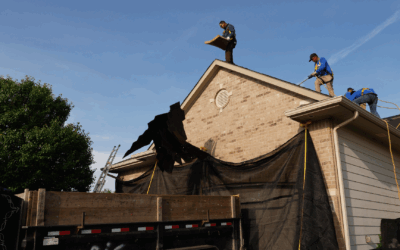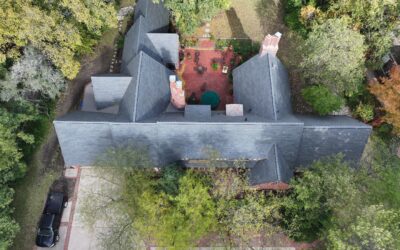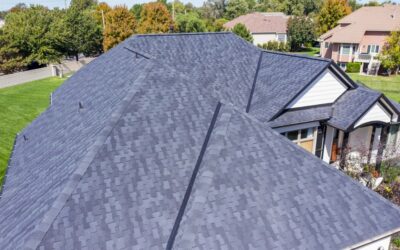Last Updated June 2025
As flat roofs are typically not visible from the ground, you typically don’t notice a commercial roof or its color. Color, then, is usually a performance and thermal efficiency question rather than a design question. In some areas of the country, like up North or in the mountains where snowfall is more frequent, black roofs are dominant because they melt snow faster and remove bearing loads from snow. In other parts of the country, like the South/Southwest where air conditioning is critical, white roofs are dominant because of lower cooling costs, or higher solar performance from reflected light onto rooftop solar arrays.
However, in the middle of the country, like where we are in Kansas and the lower Midwest, both dark and light roofs are common. Therefore, we get the question a lot: black roofs vs white roofs? In our market, which materials make more sense?
Color and Material Composition: Commercial Roofing
Material color selection isn’t independent of the material type. Modified bitumen (mod bit) EPDM, and other rubber membranes are typically dark. Older style rolled or mop-down (built-up) roofing are also dark because of the tar, and ballast systems with rock covering typically perform more like dark roofs from a thermal perspective. These dark roofing surface materials absorb heat by UV radiation. Just like wearing a dark shirt on a sunny day, a dark roof will become warm faster and remain warm longer than a light colored roof.
TPO, PVC, and metal are typically white or light-colored. Most roof coatings (retrofit coatings) are typically white as well. More reflected light means cooler surface temperatures and can mean lower energy costs for the building. However, it also means more glare if there are windows above the roofing, which can disrupt business. And similarly, light roofing tends to accumulate dust/dirt, and the dirtier look can be a downside for visible sections of roofing to some folks, like hotels, who care about the look of roofing materials from rooms above.
The color of a commercial roof is probably last on the list of priorities of business owners. But what many may not know is that the color of your roof has a significant impact on your business below.
Advantages of Black Commercial Roofing
Black commercial roofing options are typically made from modified bitumen, EPDM, or rubber roofing materials. Black naturally attracts heat; therefore, black commercial roofing systems are great for businesses in colder climates. By drawing heat, your black roof is more likely to keep your building warm and (if you only heat your building) lower your energy bills. This heating feature also reduces snow and ice forming on your roof and therefore reduces your maintenance costs and efforts.
If snow load is a concern, such as large spans or double layered roofing, narrowing a search to black roofing may make more sense. If your building use does not require cooling, then black roofing can lower maintenance costs. Finally, if glare is a concern, such as the roof of a lower lobby on the west or south side of a taller structure, dark roofing may make more sense for the comfort of the people working in the building above and aesthetic reasons.
Note that in dusty environments, like rural Kansas or life on the plains, black roofing won’t stay truly black over time. In general, we get feedback from customers that ‘dirty’ black roofs look better than ‘dirty’ white roofs because of the way dust accumulates in seams and corners – but often times with flat roofing, cosmetic appearance is only a minor concern.
Advantages of White Commercial Roofing
White commercial roofing systems are usually made from TPO, PVC, metal, or white surface coatings. A special note about roof coatings, which are used to extend the life of an aging roof in okay condition (which may or may not be appropriate – see our detailed article on Flat Roof Coatings – What Are They and When Are They Appropriate?). However, coatings are usually white, so they provide the ability to change the color of a dark roof for less than the cost of replacement.
Common in warm climates, white roofs effectively reflect light and heat from your roof and building. For a building with fully-conditioned space, like office buildings or apartment residences, this can save on cooling costs. Here in the lower Midwest, we experience true seasons; heating conditioned buildings in the winter and cooling in the summer. However, heat costs are cheaper than cooling costs, so where a business/building has to do both (especially with large surface area of roof compared with the interior area, such as a grocery store), white roofs are slightly more common. If a building use only requires heat – such as warehousing storage, agriculture, or manufacturing – the opposite may be true if the only goal energy-cost-wise is to keep interior spaces above freezing.
To reap the benefits of solar reflection and a cool roof, you need to keep your white roofing system well maintained and free of any dirt and debris.
When it comes to ice and snow formation, white roofing is not as good as black roofing at getting rid of it. Snow and ice are ideally removed as soon as possible because standing water can deteriorate your commercial roofing system, as well as (in extreme cases) structural snow load issues related to large snow accumulation.
A final motivator from some customers we have worked with for white roofing is related to the use of double-faced solar array installations on the roof. Double-faced solar panels are becoming more common as panel technology improves and becomes cheaper. It means that both the top and bottom faces of each panel generate electricity. However, that is only cost effective above a reflective surface such as a white roof. Ownership structures of commercial rooftop solar arrays vary, from private arrays to brokered lease deals that ‘rent’ the rooftop they are installed on – and different partners such as the financer may require conditions to be met, such as age of roof, structural load bearing, and white color. While Rhoden Roofing has no stake in solar installations, we do get asked frequently by customers about commercial solar arrays and have worked adjacent to installations. We have done our best to provide extensive detail from an unbiased source in our article Are Commercial Rooftop Solar Installations Financially Viable in Kansas?
Summary and Other Options
The color of your commercial roofing system affects how much heat is absorbed into the building, its ability to withstand UV rays, how much heat it contributes to its surrounding environment and your energy bills at the end of the month. Depending on the goals and purpose of the building, different projects lean toward different preferences when it comes to dark vs light roofing.
Finally, the issue is not simply black and white, as we’ve presented it here. While black and white roofing are the most common low-slope commercial material colors and the ones that get compared/asked about by customers, those are certainly not the only options. TPO comes in white, grey, or tan. You can even get patterned membrane materials, such as mimicking river rock ballast, for visible lower roofs, e.g. on a hotel lobby visible from rooms above. EPDM, while typically black, can also be found (if much less common) in light product options. ModBit roofing is manufactured with embedded granules (like a residential asphalt shingle), meaning that many colors are possible simply by changing the color of the granule – and mod-bit is also manufactured smooth, with metallic or acrylic coating applied that can be various colors.
As you explore roofing options, we’re here to help. Rhoden Roofing serves commercial property owners with advice on replacements, repairs, and ongoing maintenance through our RoofCare partnership program in Kansas, Oklahoma, Missouri, and Arkansas.
This article is part of our ‘Low Slope and Commercial Materials’ Series. Learn more about:
System Types and Surface Materials
- TPO vs EPDM
- TPO vs PVC
- Mechanically Attached vs Fully Adhered Roofing Systems
- Black Roofs vs White Roofs
- Is a Metal Roof Right for My Commercial Property?
- Can a Commercial Roof Coating Save Me Money
- 3 Best Commercial Roofs in Wichita, KS
Substrate Systems
- Polyiso Insulation vs EPS Insulation
- What Do I Need to Know About Tapered Roofing Insulation Panels?



